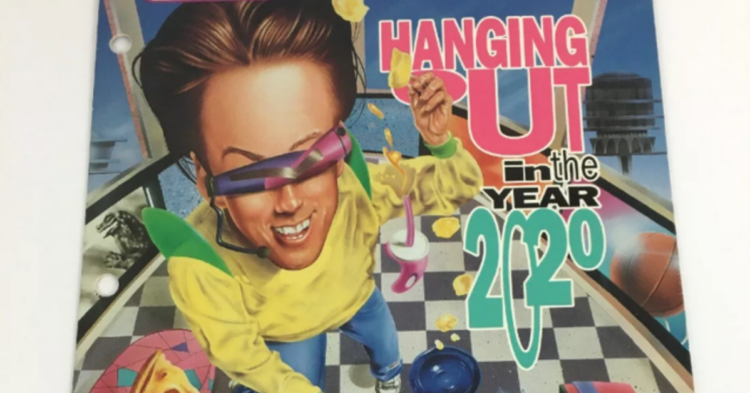It’s easy to forget that we’re constantly building the future. Even as we unwrap the latest and greatest gadgets, we have to be aware that one day it’ll either end up in a museum or a dumpster. Well, maybe it’ll be part of an ambitious recycling project, who knows?
The point is that progress isn’t stopping anytime soon, but it’s interesting to take a look back at some of the things we once thought were the latest and greatest, and are now just historical curiosities at best.
This old keyboard has buttons to connect to various internet functions.

Did anybody ever use them? You had to map each button manually, right? Not sure they were a great idea, and most of us would probably rather have a smaller keyboard instead.
This old desktop computer came with a “Turbo” button.

What exactly would a Turbo button do for a computer, you ask? Made it slower , of course.
Back in the day, software couldn’t adapt to new, higher hardware speeds, so you could click the button to “turn back the clock,” so to speak, to make your software usable as it would have been on the older machine.
This briefcase must have been made in the ’80s or ’90s considering it has a dedicated pocket for a floppy disk.

You may recognize floppy disks as the “save” icon on many interfaces. Once upon a time, before flash memory came along, floppy disks were how you moved data from place to place, like great big thumb drives.
Remember paper maps, anybody?

Because this person found an old paper map and ended up getting an adventure out of it.
“Found an old map from the 90s in a garbage dump,” they [wrote]( https://www.reddit.com/r/mildlyinteresting/comments/fi50wx/found_an_old_map_from_the_90s_in_a_garbage_dump/ . “Noticed there was some train tracks that aren’t there now and found this abandoned train station.”
There was a time when that might have been the start to a Spielberg flick.
Ah yes, the healing power of radium.

Back in the 1910s, radium started to be incorporated into medicines and for a time, it was put in all kinds of products as a sort of “cure-all.”
Of course, radium is incredibly radioactive and is pretty much the opposite of a cure-all.
This Monopoly board is about 70 years old.

What’s most remarkable about it is how little the basic game has changed in that time. Sure, there are hundreds of different versions of the game now, but at its core, it’s still the same game.
About the only difference I can see is that there’s no car game piece; there’s a battleship instead.
This TV remote appears to be from an era when you could get away with buttons that go from 2 to 13.

There must have been a time when you couldn’t imagine there possibly being more than 13 channels. Of course, we went way, way beyond that, and now, if you’ve “cut the cord,” even channels themselves are a thing of the past.
Here’s a relic of a tragic time.

From the days in which hyperinflation rocked Germany following the First World War, this is a 50 million mark note.
It’s a snapshot of what must have been a surreal time – in January 1923, a loaf of bread cost 250 marks, but by November, it cost 200 trillion marks.
Compare these two ways of opening a soda can.

The modern one is at the top, clearly, but on the bottom, you can see the pull tab you used to have to remove from a can to be able to drink from it.
And even before that, you would have seen cans like this.

Without even a pull tab on top, you’d have to pierce the can’s top with a knife or a specialized can puncher to quench your thirst.
Between the under-the-tongue and the in-the-ear thermometers, let alone the lasers, there was this.

It’s a strip thermometer intended for kids – you’d press it to their forehead to get a temperature reading.
I wonder if McDonald’s would still honor this coupon.

I don’t see an expiry date on it, and it looks like a generous offer, so maybe give it a shot? I think the big difference between this and today’s coupons is all those adjectives – today they’d just write “One free hamburger, shake, and small fries.”
Going to go out on a limb and say this watch is from the mid ’80s.

You know, right around the big Transformers craze. Not sure that it’s even remotely practical as a wristwatch, but is it wrong that I want one?
What they thought 2020 would look like in 1993.

Well, at least what the good folks at Trapper thought it would be like. One thing they got right: pizza remains as popular as ever.
Just imagine this mess of lines overhead.

This was the reality in Stockholm, Sweden, in the late 19th century, when more than 5,000 phone lines connected to the Telefontornet tower.
Fun with old TVs and magnets.

And, having grown up with a CRT TV myself, I’m highly reluctant to get magnets anywhere near my new TVs, too. Don’t want to even risk messing them up!
And yes, magnets could do some serious damage to a CRT TV.
It’s hard to fathom there was ever a time when you didn’t have to have an awful picture of yourself on your driver’s license.

But it makes some sense that back in the ’60s, the tech might not have been there for such things. Oh, the simpler times.
These were supposed to look less intimidating than standard gas masks.

An attempt was made, right? Following the attack on Pearl Harbor, folks rightly wanted their kids to feel safe, so they made Mickey Mouse-themed gas masks.
Thankfully, they were never needed.
Before the development of radar, this was an aircraft early warning system.

Anybody envy this guy’s job? You’d think they could have incorporated a chair into the design, and maybe a cupholder, right?
About a hundred years ago, female teachers might be expected to sign a contract like this.

Is it any wonder teachers organized and unionized given such restrictive working conditions?
People have always wanted their own tunes in their cars.

Before satellite radio and MP3 players, before CD changers, tape decks, and even 8 track players, people were trying to put record players in their car stereos. Not sure how well they would work on the go, to be honest.
Back in the 19th century, this was a fancy pocket notebook.

These thin tiles were made from ivory, and you wrote on them in pencil so you could erase your notes and re-use the tiles as you needed.
Back in 1987, personal computers were taken on parade in East Berlin.

Not sure if that’s a distinctly ’80s thing, a distinctly East German thing, or an entirely ’80s East German thing, but there it is.
This is the guts of the computer that was on board the Apollo 11 Moon landing mission, weighing in at a mighty 14 kilobytes of memory.

I wouldn’t be shocked if that Transformer watch had more memory. Kind of makes that mission that much more impressive, doesn’t it?
This early 19th century needlework instructional manual came with examples right on the pages.

Really, before YouTube, this was a pretty practical, if expensive, way to get the info across.
“My Great-Grandfather’s social security card was made out of metal, not paper,” wrote the uploader of this pic.

Now, was that standard, or a special case? Maybe a custom order? Because metal would have to be a costly thing to issue to absolutely everyone, wouldn’t it?
The next time I’m stuck in traffic, I’m going to think of this video.
It’s a recording of a San Francisco streetcar navigating the streets circa 1906. It’s a miracle it didn’t collide with anything.
This is what the interior of a passenger plane looked like in the ’30s.

Yep, basically wicker lawn chairs lining the central aisle. Okay, now I feel a little better about the leg room in coach.
The last time anybody officially tried to settle a dispute via duel in France was 1967.

Two politicians went at it with swords over an insult delivered in Parliament. They did not fight to the death; the duel ended when one of the combatants had twice wounded the other, albeit not seriously.
Another one of those things that doesn’t change is builders leaving a little something behind.

This brick that initially went into a house back in 1897 shows where the bricklayer sketched out the pattern for the chimney crown. It’s almost like they signed their work.
This was once the cutting edge in photo-on-the-go technology.

And the kind that could fit in your pocket, too – it’s a Polaroid camera. They were definitely neat, but I still prefer my phone.
This odd looking pot served a particular purpose.

To sterilize bottles and flasks, the pot would be filled with water and boiled, while the bottle or flask would go inside a ring of the appropriate size to allow it to stand up. Neat!
















































